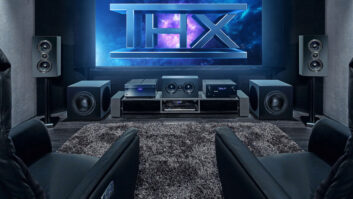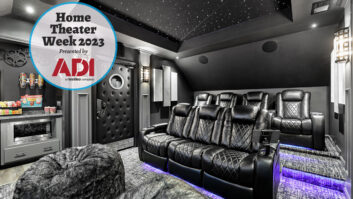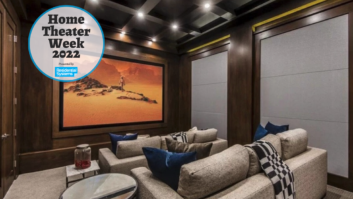The fully connected home, one in which data and information flow freely to empower devices with a new type of electricity, is the stuff of dreams for the CE and IT communities alike. The ability to listen to music, watch pre-recorded or home videos, engage in multi-player gaming or view digital photos from anywhere inside and outside the home are all part of this vision. The complexity and compelling nature of the connected home have installers, far and wide, sensing the opportunities that are brewing. Customers needing guidance and assistance in making this a personal reality. And yet, the old tensions exist: will consumers do it themselves or hire a professional custom installer? Current research points to a tremendous opportunity for the installer just waiting to break open.
So far, things haven’t looked great for the home network installer. According to the latest research from the Consumer Electronics Association (CEA), of the eight million households with a home computer network, 94 percent handled network installation on their own. However, the nature of the current market shows why things are not as bleak as they might seem. Still in the infant stages of the market, the current owners can clearly be classified as early adopters. These are sophisticated users with a high level of technical knowledge and a relative comfort with installing and configuring a home network.
Further, the bulk of current home network applications is fairly simplistic. The majority of owners (68 percent) responding to a recent CEA survey listed sharing an Internet connection as their major reason for owning a home network. With two-thirds of network owners connecting to the Internet via broadband, sharing a connection has been the killer app for home networks thus far.
The good news for the installer is that consumer attitudes are changing as quickly as the technology. The undercurrents of this change can be seen among the current group of owners. Despite their skill set and the simplicity of the systems, the need for outside assistance is apparent. Many of the self-installers had to call technical support for help through the process. More than half (57 percent) called their ISP for help, 43 percent called the router/network card manufacturer. By itself this is not an indicator of a huge groundswell of interest in custom installation. However, the need for assistance is only likely to increase as both the consumer profile and the desire for more complex systems increases. Already, consumer’s usage patterns and desired features are pushing the home network beyond merely a shared Internet connection. Many consumers are using their networks to manage and listen to digital music (69 percent) or play multi-player games (58 percent). As more network-enabled devices come out on the market these alternate uses will expand over time.
Buying requirements among non-owners also points to the increasing need for a network installer. For these consumers a shared connection alone is not enough reason to own. They have not purchased yet because for now they don’t see the benefits (47 percent list this as a major reason for not owning). Though sharing an Internet connection is compelling to them, most of the non-networked households aren’t broadband-enabled and thus place a lower value on shared connections.
As consumer needs and requirements change and the availability of networked products increases the business of installing a home network is getting more complicated. Beyond the considerations of how to connect, whether wired or wireless and which standard, consumers have to think about what they want to connect together and how best to administrate the connection. How many computers or other devices need to be connected now and in the future? Is there a set-top box or home entertainment system that could be connected in? And then what about other home automation or security? This certainly leaves the consumer with a lot to think about.
Enter the network installer–perhaps better thought of as a network consultant. Consumers need, and are beginning to look for, the services of a consultant to make sure their system can handle the current demand and any additional service they may want to add in the future. It really is no different than an HVAC system or plumbing system in the home. Both are considered too technical for the layperson to manage. In truth these are nothing compared to the complexity of distributed content, shared connections, multiple types and numbers of connected devices, and underlying infrastructure. Consumers need help in realizing the vision. The challenge for marketers is to make home networks sound advanced and sophisticated by presenting the full range of applications, without making it so daunting the consumer is turned away at the gate.
Research holds some good news for installers on the consumer-interest front. For one, consumers have already expressed some interest in using the installation services of well-known retailers. Almost one-quarter of consumers said that they are likely to use Best Buy’s network installers. Another 22 percent said the same of CompUSA. Other retailers have a farther road to travel in selling their services, but the opportunity is there nonetheless. Clearly associating a brand with network installation is becoming important to the mainstream consumer.
While the grand concept of the networked home still is jelling in the minds of consumers and the service sector develops, broadband will continue to serve as the ultimate driver for home network adoption. This is particularly true of the 22-million multi-PC households who need a shared connection.
Though networks centered on shared connections remain among the simpler forms of networking, this will help pave the way for network installers to offer add-on services and upgrades in the future. This is already underway as many of the current networked consumers look to add displays in other rooms of the house. Holding onto the vision of what the truly connected home can be will help the creative installer come up with affordable options for consumers at all levels of need.
Sean Wargo is a senior industry analyst with the Consumer Electronics Association (CEA) in Arlington, Virginia.







